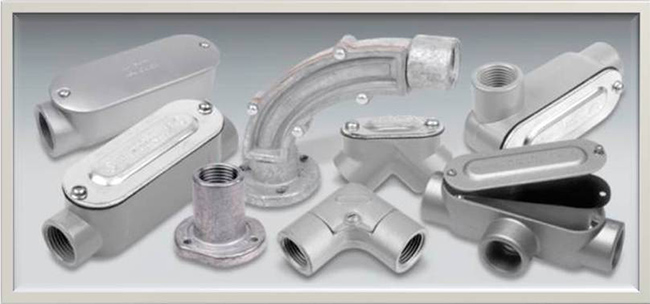Electrical conduits are typically used to run, support, protect and route electric wires in a circuit. When electrical conduits are installed along structural construction joints they are prone to damage, as construction joints may experience shear and lateral loads due to gravity resulting into expansion and contraction in the conduits. Not only is there stress caused by structural movements, but there is also thermal stress arising from either an increase or decrease in temperature. Therefore, while designing electrical conduits, careful attention should be paid to accommodate potential expansion due to thermal and physical stress.
An expansion/deflection fitting is generally used where an electrical conduit crosses a structural joint that is intended for expansion, contraction, or deflection. Such structural joints are found in buildings, bridges, parking garages, or similar structures. The expansion or deflection movement arises across the joints and hence the running conduits may be either axial or angular. These expansion/deflection fittings are designed such that any axial or angular movement in the conduits is accommodated and any potential damage to the electrical conduit or cables inside the conduit is prevented. This ensures the continuity of the circuit. Expansion fittings also provide for thermal expansion, permitting relative movement between the conduits in response to ambient temperature fluctuations or for any other reasons. The expansion fittings must not only provide for relative movement between the conduits, but also must maintain ground continuity across the conduits during such movement. Depending on the need, each expansion or deflection joint is designed to absorb a particular amount of deflection as well as expansion.
Depending on the type of electrical conduits that need to be connected and the extent of expansion or deflection that needs to be accommodated, there are different types of expansion deflection fittings that are available.
-
Rigid Expansion AX300 – This comes in a 3-inch trade size and allows for up to 4 inches of expansion – 2 inches in either direction normal to the conduit. The fitting is used for connecting rigid conduits.
-
The EMT Expansion TX 300 – This joint would allow expansion/deflection in an Electrical Metallic Tubing (EMT). These also allow a maximum of 4″ conduit movement (2″ in either direction). TX 300 includes the EMT connectors and conduit nipple.
-
PVC Expansion Carlon – As we know, PVC material has a tendency to expand or contract more in response to temperature fluctuations, when compared to other conduit materials like steel or aluminum. The coefficient of thermal expansion for PVC (3.38 x 10-5 in./in./°F), is about 3 times the coefficient of thermal expansion for aluminum and six times as high as that of steel. Where conduit runs are long, the impacts of temperature changes are significant. In order to accommodate the changes in length due to temperature changes, Carlon expansion fittings for PVC are extremely useful. The use of expansion fitting prevents potentially harmful thermal stresses in the conduit itself or in any supporting structures. PVC Expansion fittings are advisable when the straight run length for the electrical conduit is greater than 25 feet and expected temperature change is greater than 60 °F.
-
Deflection DX300 – The DX300 is intended to absorb movement in any direction between two conduit ends where they connect. These will withstand occasional vibrations transmitted to conduits by rotating equipment or vehicular traffic. The DX300 allows for 30 degrees of bend in any direction and and ¾” of expansion or contraction.
-
Combination AXDX300 – This Expansion/Deflection fitting allows for ¾” of expansion or contraction and 30 degrees of bend in any direction and allows for 4 inches of conduit movement, 2 inches in either direction normal to the conduit. The total expansion or contraction is 2 3/4”.






